Jacques Cousteau is a famous marine researcher, oceanographer, and film technician, known to many as “The Father of Diving.”
Cousteau’s contribution to science and diving is invaluable. He produced more than 115 documentaries and was the inventor of the Aqua Lung, the basis of what we know today as SCUBA diving.
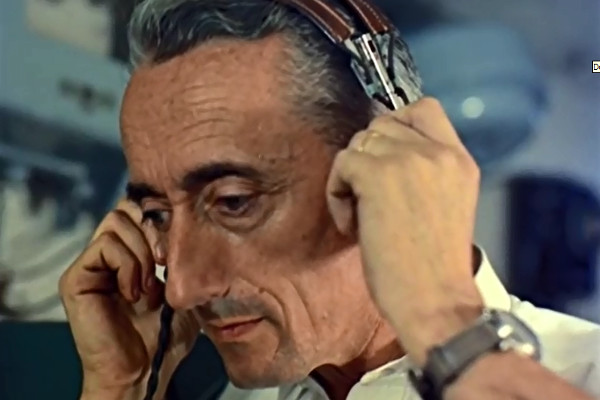
One of his first and successful productions was “The silent World”. A beautiful documentary filmed in the 50’s, full of beautiful scenes, although a few of them very controversial.
About “The Silent World”, by Jacques Cousteau
The Silent World is a full-length documentary produced by Jacques-Yves Cousteau and Frédéric Dumas, which summarizes the explorations of the Calypso during the years leading up to its release, especially 1955.
An interesting fact about this documentary is that its filming was possible thanks to two innovative technologies of the time: the CG45 regulators developed by Cousteau and the underwater cameras designed by André Laban.
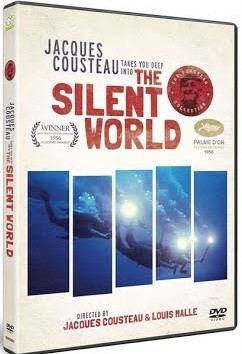
The Silent World was the first documentary to show underwater images fifty meters deep and the second to do so in color.
The documentary also received several awards. One of the most prominent was “La Palma de Oro” in 1956, at the Cannes festival.
Controversial scenes
While “The Silent World” was a critically acclaimed and award-winning documentary in its day, it has some highly controversial scenes that contrast with Jacques Cousteau’s passion for the marine world.
It is important to remember that this documentary was filmed almost 75 years ago, when environmental conditions and world reality were very different.
The controversial scenes of the documentary “The Silent World” are the following:
First: Two crew members destroy a coral reef with dynamite to study dead fish.
The first controversial scene begins at minute 23 of the film. The narrator explains that marine biologists sometimes use dynamite to study the coral reef.
The documentary clarifies that using dynamite for commercial fishing is illegal and considered an act of vandalism, but that for scientific purposes it is the only method that allows them to know all the species that inhabit (inhabited) that specific reef.
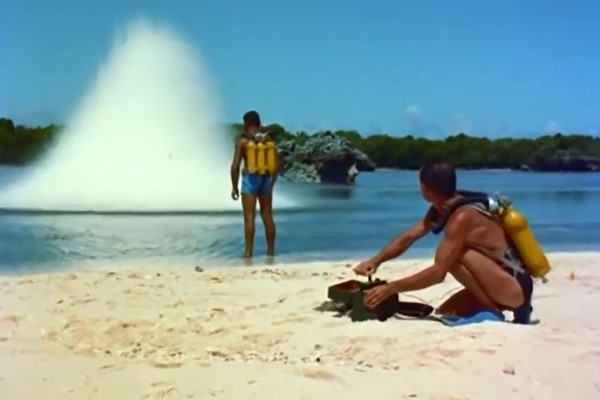
Currently this method is no longer used for scientific purposes and the use of dynamite for fishing is prohibited in most parts of the world.
Unfortunately, in Southeast Asia this practice is still used for fishing. Explosives cause irreparable damage to coral reefs and serious environmental impact.
Despite being such a harmful practice, it is important to mention that the main threat to coral reefs today is not fishing with explosives, but global warming and the increase of CO2 in the water.
You can see the full reef explosion scene and fish count below.
Second: Ride a sea turtle for fun.
Moving a little further in the documentary, in second 29, we find another controversial scene.
On this occasion, one of Jacques Cousteau’s team divers puts aside his scooter (Underwater Motor for Rapid Propulsion) and holds onto a large sea turtle that he found in his path.
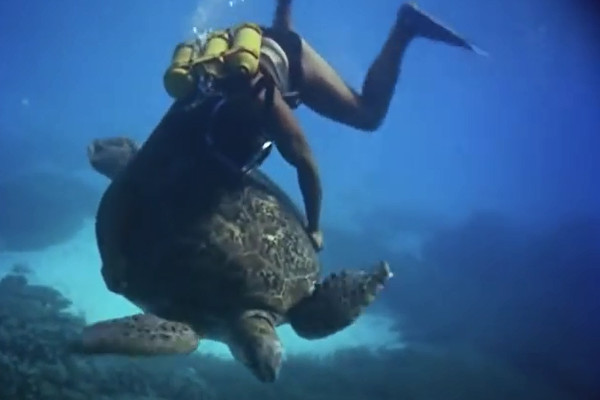
The animal, feeling the diver on its back, begins to swim hard to try to escape. Finally, the turtle gets tired and the diver releases it to continue its way.
This encounter did not result in any physical harm to the animal. However, today every diver knows that good diving practices include respecting animals and keeping a safe distance from them.
Today things have changed. In fact, the third golden rule of the CEMAS organization, founded by Jacques Cousteau, states the following:
“Respect for the animals and plants in the background is paramount. [The diver must] Keep a distance from the corals and do not touch anything.”
Here we share the video of the diver riding a sea turtle.:
Third: Jacques Cousteau’s Ship Calypso Runs Over and Kills a Baby Whale
Later, the Calypso has a special encounter with a group of whales.
In total, 27 cetaceans swam in front of the boat. Most adult whales and several calves. Unfortunately, one of the calves was swimming slow and Cousteau’s ship ran over it.
The Calypso’s propeller cut several deep cuts into the animal, causing fatal injuries. The crew had no choice but to hasten the whale’s death and using a harpoon they ended its life.
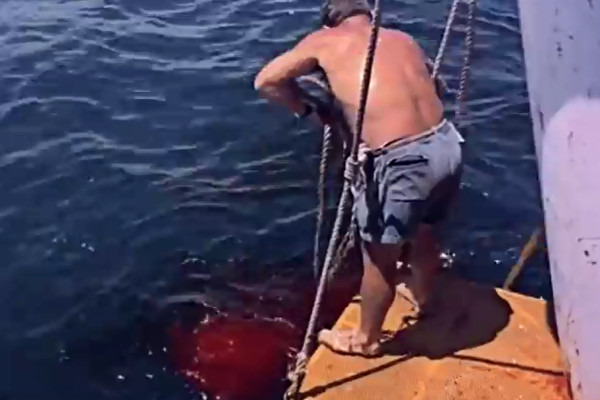
Although this was not an intentional incident, it does carry great responsibility.
Obviously, when the Calypso’s crew encountered the whales, they did not follow any kind of whale watching protocol. On the contrary, instead of going away, they continued sailing very close behind the group.
Today there are many organizations in different parts of the world such as ACCOBAMS, FRIMM, ASOCIACION CETACEA that have signed and established agreements that regulate encounters with cetaceans.
In general, these regulations focus on three aspects: The minimum distance to maintain (100m), the maximum time in the place (30min) and the actions of the ship during the time of the sighting.
Within the actions of the boats some limitations are established such as: Never navigate around the group and stop the engines if the animals approach.
Perhaps they were other times, but following these basic regulations would have avoided the situation experienced in the video by the Calypso Crew.
Here you can see the full scene of the calve tragedy.
Fourth: Jacques Cousteau’s team Kill a group of sharks without justification.
As mentioned in the documentary, the Calypso’s crew was not the only witness to the whale’s death.
Due to the large amount of blood spilled in the sea, many sharks began to approach. Of various types and sizes.
At first there were a few, but within minutes the waters around the boat were full of them. The dead whale represented a great feeding opportunity.
“For us divers, sharks are deadly enemies. We have met them, but never so many and so hungry “
For the crew of the Calypso this was a great opportunity to film and document for the first time in history so many sharks feeding at the same time.
For this, Jacques Cousteau used a special cage in which two crew members descended with the necessary film equipment.
Suddenly, what until now had been an opportunity for biological observation turns into a holocaust.
The crew, following the narrator’s phrase “Every sailor hates sharks”, take harpoons, sticks and axes to extract from the water and exterminate every last one of them.
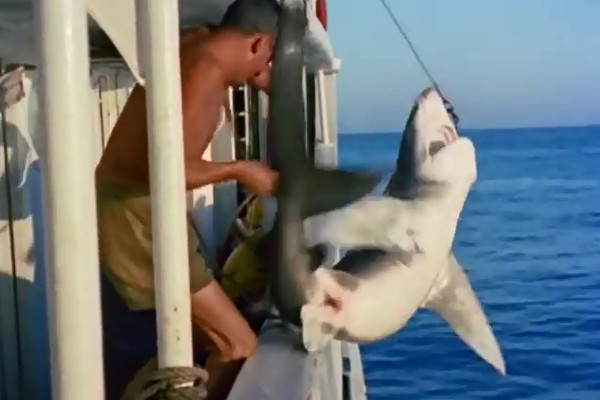
Today we know that sharks are not our enemies. Rather, they are a vital part of the marine ecosystem and require our protection.
We also know that they are not our killers and that attacks on people happen very rarely, mainly when the shark gets confused.
See also: 10 Things deadlier than Sharks
Some organizations such as Shark Alliance, UNEP, CRAM, Fundación Keto (in Costa Rica) have developed international agreements and programs that regulate and seek to protect sharks.
Nowadays, an action like the one shown in the video would have cost Cousteau a gigantic fine and possibly serious legal consequences.
Here you can see the scene of the shark slaughter.
Fifth: Mount tortoises in Galapagos
Although the previous situations could find some kind of justification, based on the time, motivations or existing regulations, the latter action is more difficult to understand.
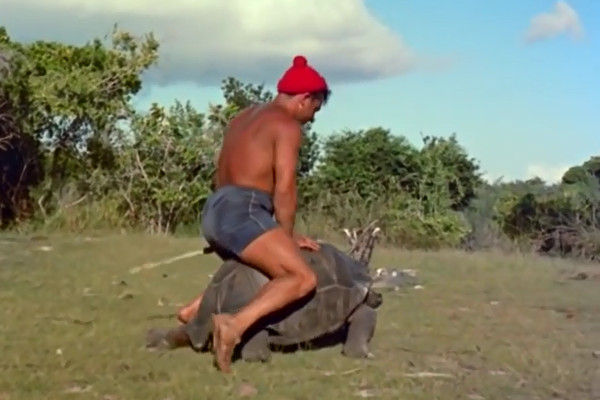
After a long journey, the crew reaches a “desert island of dreams”, as the narrator calls it. Apparently, it is the Galapagos Islands.
On the island they find a great diversity of animal species. Birds of all kinds, giant crabs and turtles, among others.
Upon finding the giant tortoises, the crew begins to have fun with them. They ride on their shells like horses and stand on them forcing them to walk with extra weight.
Finally, they enjoy their snack time using the animals as chairs.
The scene of the turtles is a clear example of disrespect towards animals. One of the fundamental principles when interacting with nature is to respect its space and avoid touching the species with our hands.
You can see the scene of the turtles below.
Other times, another mentality.
When viewing the documentary, it is necessary to place the film in the context of the 1956 public’s discovery of the marine world.
The perception of nature at that time was very different. There were no environmental debates or protection of marine species.
For this reason it is understandable that the public and the authorities of 1956 did not show any reaction of protest when seeing these scenes contained in Jacques Cousteau’s documentary.
Jacques Cousteau’s World of Silence, summary.
Despite these situations that have sparked criticism in the 21st century, The Silent World remains one of the most beautiful works that Cousteau made.
Looking at the scenes discussed above, we can feel happy that we have improved something and that although the environmental challenges are greater today, so are the conservation and awareness efforts.
If you have questions or comments, we invite you to write us a comment. And if you come to the South Pacific of Costa Rica, send us a message. We are passionate about diving and the conservation of marine species.
Tips to protect marine species in 2022
As we have mentioned before, today there is a new way of thinking in relation to marine species and biodiversity. Here are some tips to be an active part of caring for marine nature:
Use less plastic products: not only so that beaches do not become dumps for waste, but also to prevent marine animals such as whales from ingesting plastic debris.
Buy sustainable seafood: Do not consume products derived from endangered marine animals.
Use biodegradable products on the beaches: This is a way of not leaving pollutants on the beaches, which can later harm marine species.
Reduce CO2 emissions: Despite being far from the beaches, and since everything is connected, CO2 emissions contribute to global warming, which is bad for marine species.
Do not throw cigarette butts on the streets: Much of these pollutants end up in the water, and they contain very strong chemicals, which end up being ingested by marine animals.
